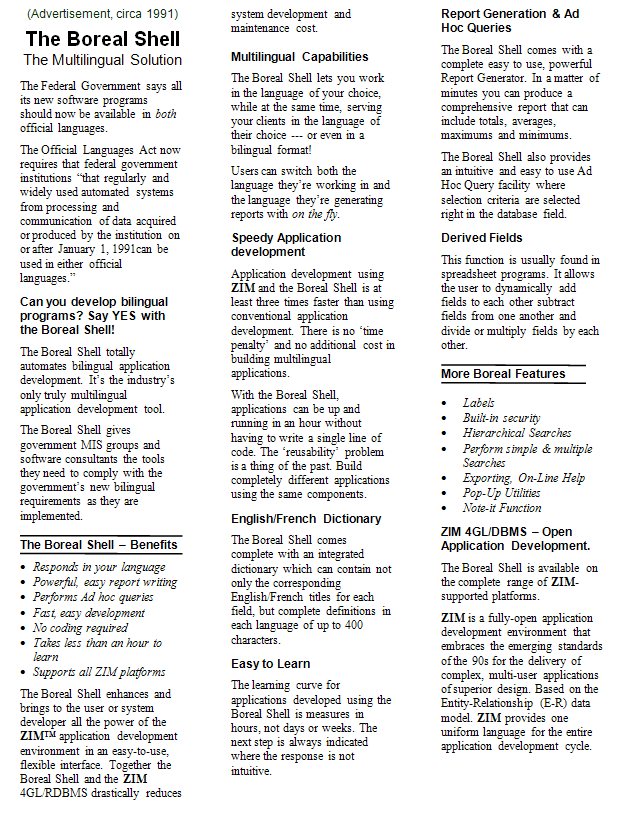Boreal
SHOOTING THE MESSENGER
The Shell to the Rescue

![]() Denis
was a man with a big problem on his hands. He was the civil engineer in charge
of a computer project to catalogue all assets for which the Federal Government
was responsible in the more than 800 First Nation communities, i.e., reserves,
across Canada, and that included everything from roads to fire halls and
firefighting equipment, water treatment plants, schools, etc. His first attempt
at creating a database had taken more than a year and was an abject failure; the
highly touted American DBMS (Database Management System), PowerBuilder, proved inadequate for
the task. Indian Affairs would be the first to adopt the Boreal Shell. There
would be no pilot; there was not the time.
Denis
was a man with a big problem on his hands. He was the civil engineer in charge
of a computer project to catalogue all assets for which the Federal Government
was responsible in the more than 800 First Nation communities, i.e., reserves,
across Canada, and that included everything from roads to fire halls and
firefighting equipment, water treatment plants, schools, etc. His first attempt
at creating a database had taken more than a year and was an abject failure; the
highly touted American DBMS (Database Management System), PowerBuilder, proved inadequate for
the task. Indian Affairs would be the first to adopt the Boreal Shell. There
would be no pilot; there was not the time.
Government departments are notoriously shy about trying unproven Canadian technology like the Boreal Shell, and to make matters worse, it was based on a Canadian DBMS with the unfortunate name of ZIM, a name which completely obscured the powerhouse that was the ZIM DBMS and the ZIM fourth-generation language.
To get my first customer, I made Denis a promise that normally would have been considered reckless. I promised him that, using ZIM and the Boreal Shell, and starting from scratch, I could have the thing done in four months. Not only that, but it would include a user-friendly interface and a feature that no other database product on the planet offered at that time: the ability to respond to the user in the language of his or her choice, in this case English or French, and produce reports on the fly in either language. If I did not deliver what I promised within the agreed-upon timeframe, he did not have to pay me. He was impressed enough that he gave ZIM and the Boreal Shell a chance, and he never looked back.
The system, which became known as CAIS for Capital Asset Inventory System, was built within the time allowed and implemented within all the Indian and Northern Affairs (INAC) regional offices across Canada. With the success of CAIS, I was asked to build the more complicated companion system, ACRS (Asset Condition Reporting System, pronounced acres). Every year, the Department of Indian and Northern Affairs must estimate and allocate the amount of money it will need to maintain First Nations’ community assets in good working conditions and to track projects related to the maintenance of these assets. This was the role of ACRS. ACRS won the Deputy Minister's award for excellence, coming in on time, under budget, and exceeding requirements and user expectations.
With the Boreal Shell as my calling card and satisfied customers, the next few years were good for business and the debt we had accumulated after my first firing started to dwindle. Then the proverbial butterfly flapped its wings, not in Beijing, but in a desert of Iran.